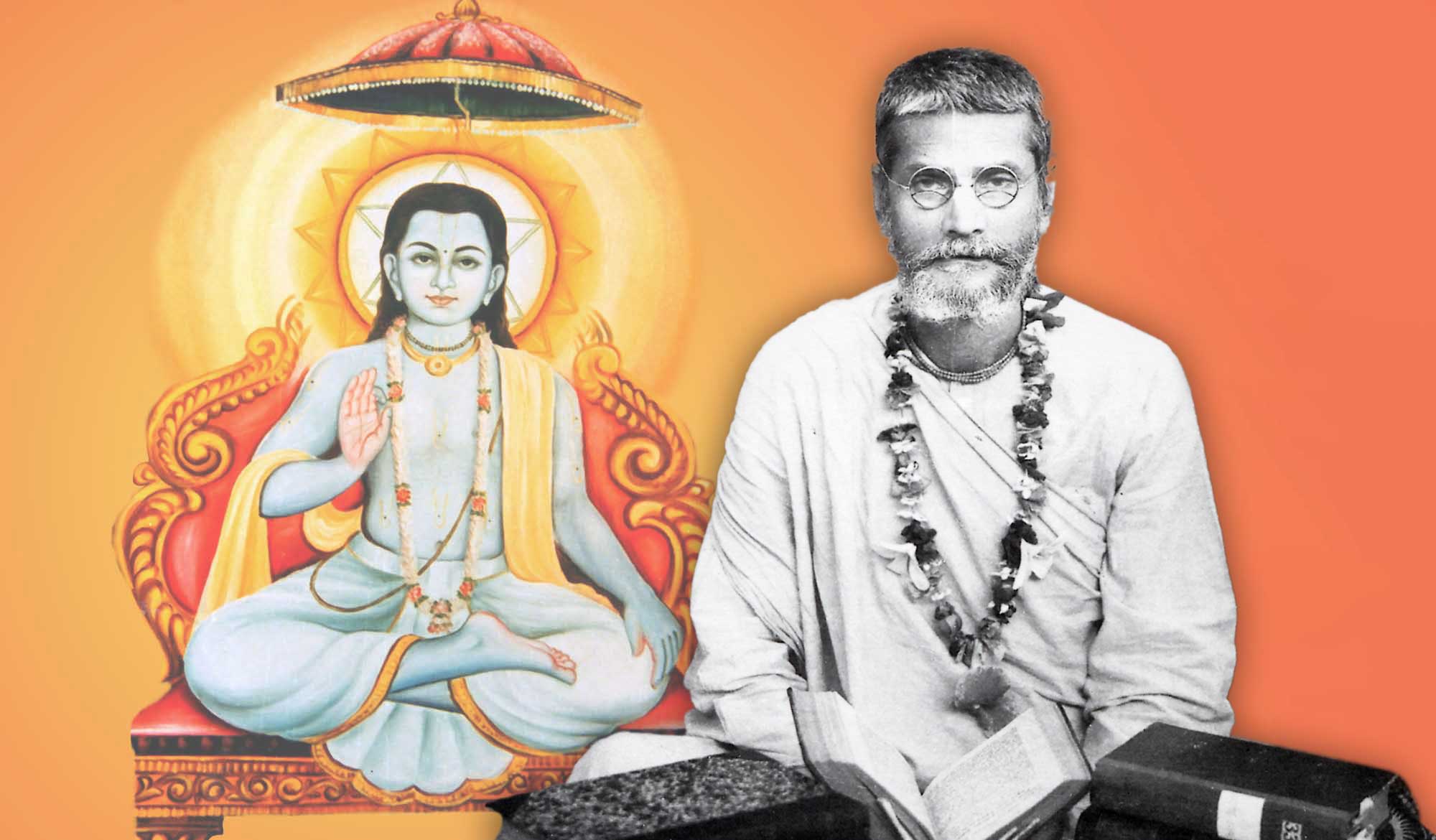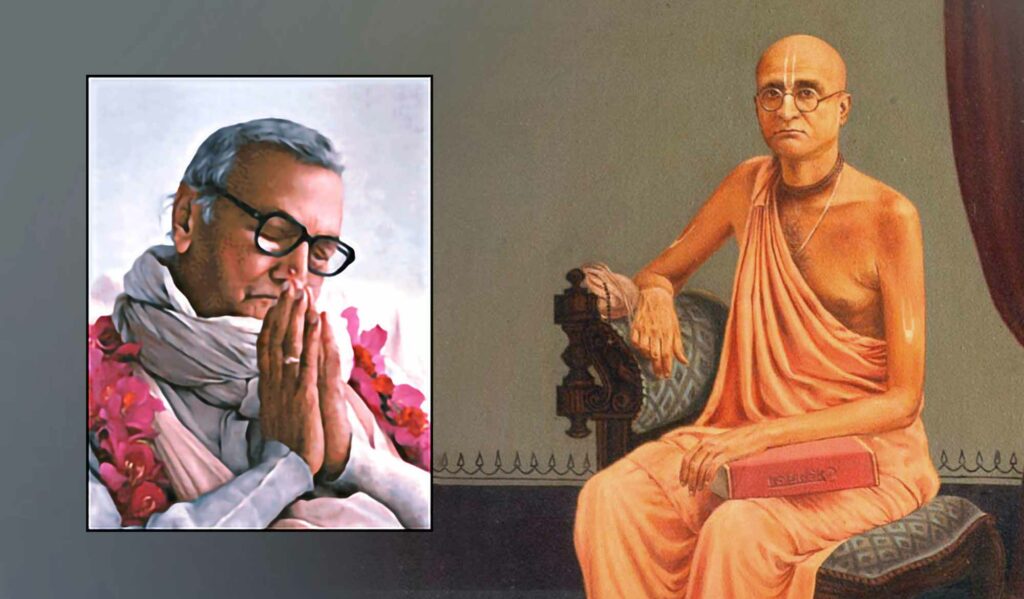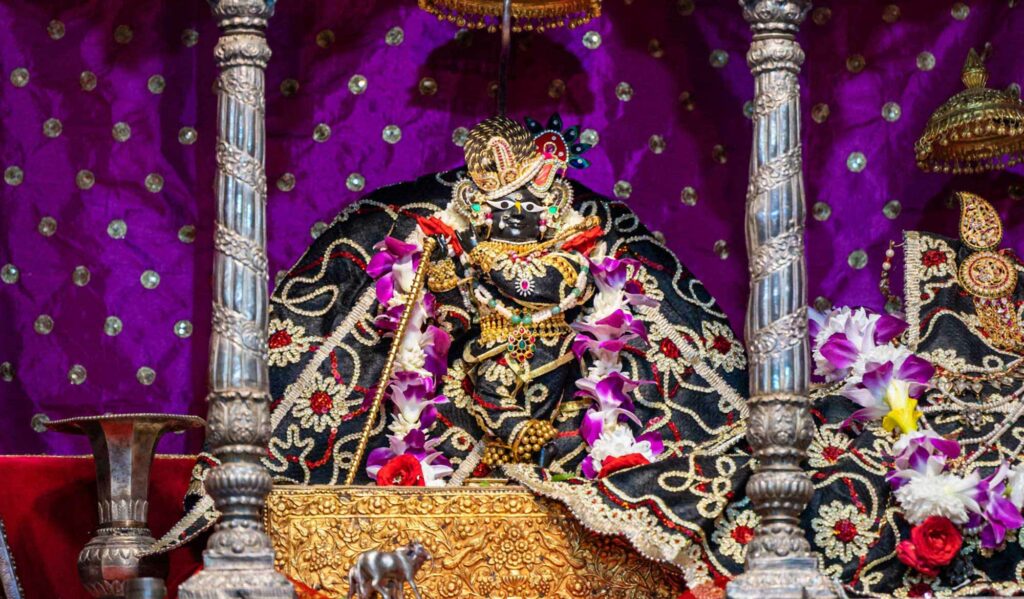Overview
In a previous article by Śrīla Narasiṅgha Mahārāja on Nimbārkācārya, there was mention of an article written by Śrīla Bhakti Prajñāna Keśava Mahārāja on the same topic. Some devotees have requested us to publish this article, which was originally written in Hindi and published in Bhāgavat Patrikā, Vol. 2, Issue 2, in July, 1956.
There is no mention of the sampradāya of Nimbārka anywhere in the śāstra. Amongst the four ācāryas, the name of Nimbāditya Svāmī is mentioned in some Purāṇas. This Nimbāditya has been accepted by the Catuḥsana, i.e. Sanat-kumāra etc. as the ācārya of their sampradāya, not Nimbārka Svāmī. Some people try to prove Nimbāditya and Nimbārka to be the same person on the basis of some interpolated ślokas from the Bhaviṣya Purāṇa, but we do not agree with them on this matter. Although some ācāryas of the Nineteenth and Twentieth Century have referred to Nimbāditya Svāmī as Nimbārka Svāmī, this is only a conventional reference to those people, the basis of which is simply public hearsay. Actually, Nimbāditya and Nimbārka are not the same person. Those who consider Nimbāditya to be a very ancient ācārya refer to him as a direct disciple of Nārada. In such a situation, Śrī Vyāsadeva and Nimbāditya seem to be godbrothers of one another. However, even an ordinary researcher can understand to what extent it is logical or compatible with historical evidence to consider Nimbārka Svāmī to be a contemporary of Vyāsadeva. Even if this is accepted for the sake of logic, only Nimbāditya Svāmī can be accepted as a disciple of Nārada, and not Nimbārka Svāmī.
The word āditya means arka (sun), hence some people want to call Nimbāditya as Nimbārka by using nimba + arka, instead of nimba + āditya. Yet on the basis of this point of view alone, the ancient Nimbāditya and the modern Nimbārka Svāmī cannot be considered to be one person. Śrī Rāmacandra is also called Raghunātha. If someone calls him Raghupati then no one can have any objection to that. Similarly, if any Vaiṣṇava ācārya has referred to Nimbāditya as Nimbārka in some place, then there is no specific objection to that. Still, it is appropriate to consider the classical Nimbāditya only as Nimbāditya. Nowadays, due to some new sampradāyika scholars, some people want to establish the modern Nimbārka as the ancient Nimbāditya. But this idea of theirs is not logical in any way and is not proven by historical evidence. Nowadays, no book or sampradāya of the ancient ācārya Nimbāditya is available. No existence of this sampradāya was found in India until the Fifteenth Century. In one or two places, for some personal reason, some maṭhādipati (head of a maṭha) has referred to himself as the maṭhādipati of the Nimbāditya sampradāya, but there is a difference of opinion as to whether these people were the maṭhādipatis of the Nimbāditya or Nimbārka sampradāya or not. Previously, the famous literary figure of Bengal, Śrīyuta Akshay Kumar Datta traveled all over India to research the history of Indian philosophy and religious sects. In that investigation, he did not find the existence of any Nimbārka sampradāya anywhere between 150 to 200 years previously. He has only mentioned that in ancient times, a sampradāya with this name was prevalent, but at present its existence is not seen. We do not consider the theories of Paṇḍita Akshay Kumar Datta as the whole truth, yet we completely agree with the fact that in the Fifteenth and early Sixteenth Centuries, the Nimbāditya sampradāya was counting its last breaths.
The author of the Pārijāta Bhāṣya which is prevalent in the Nimbārka sampradāya is not Nimbāditya Svāmī. Śrīnivāsa Ācārya (*see footnote) and Keśava Kāśmīrī have themselves written this Pārijāta commentary on the Vedānta Sūtra and propagated it as being written by Nimbārka Svāmī. Prajñānanda Sarasvatī of Barishal District in East Bengal has, with great endeavour, written a huge book named Vedānta Darśana Itihāsa (‘A History of Vedānta Philosophy’). The author was an opponent and hater of Gauḍīya Vaiṣṇavas and all the sections of that book are not based upon pure principles, however, in it Keśava Kāśmīrī has been described as a disciple of Nimbārka Svāmī. Therefore, both Keśava Kāśmīrī and Śrīnivāsa Ācārya are disciples of Nimbārka Svāmī. In order to perform his dig-vijaya (conquering all directions), Keśava Kāśmīrī travelled to different places in India defeating many yogīs, jñānīs, tapasvīs, the followers of Saṅkhya philosophy, and many paṇḍitas, and then he reached Navadvīpa. There he was defeated by the sixteen-year-old youth, Nimāi Paṇḍita (who is directly the Supreme Lord) and with great shame he meditated upon Sarasvatī Devī. On the order of Goddess Sarasvatī, he heard from Śrīman Mahāprabhu primarily about the concept of Acintya–bhedābheda–tattva from the religious scriptures. He became extremely fascinated upon hearing those concepts, and being influenced by them, he started his own sampradāya. Even after he was defeated according to śāstra and had surrendered at the feet of Śrīman Mahāprabhu as per the instructions of Sarasvatī Devī, Keśava Kāśmīrī’s remorse did not go away in his old age. The fire of hatred in his heart could not be completely extinguished. The same fire is still reflected within the Nimbārka sampradāya. Due to that same hatred, he, along with his elder godbrother and śikṣā-guru, Śrīnivāsa Ācārya, composed a commentary on Vedānta Sūtra called the Pārijāta Bhāṣya, and in order to establish the authenticity of that treatise, he started trying to propagate it within the Vaiṣṇava community by saying that it was written by Nimbārka. Then both of them also wrote commentaries on that commentary separately, under their respective names. The main purpose of these commentaries is to show that the Pārijāta Bhāṣya was not composed by them, but was composed by their Gurudeva. Analysing the period of Keśava Kāśmīrī and Śrīnivāsa’s appearance, it is clear that when Śrīman Mahāprabhu was performing His gṛhastha-līlā, both were present in their old age.
On meeting Śrīman Mahāprabhu, Keśava Kāśmīrī felt embarrassed to introduce himself as an ācārya of the Nimbārka sampradāya. Therefore, he kept his identity secret. The reason for this was that up until that time, no book had been composed in the Nimbārka sampradāya or up until that time, the Nimbārka sampradāya could not make an impact on Indian history. That is why there is no mention of the Nimbārka sampradāya found in any of the Gosvāmī texts. If the Nimbārka sampradāya had existed at all during the period of the Gosvāmīs, then Jīva Gosvāmī or Rūpa-Sanātana and the other Gosvāmīs would certainly have mentioned the Nimbārka sampradāya. References to ācāryas such as Rāmānuja, Madhva and Viṣṇu-Svāmī etc. are found in the works of the Gosvāmīs, but no mention is found anywhere in relation to Nimbārka. It is only due to the rise of Keśava Kāśmīrī that a new sampradāya emerged in opposition to the Gauḍīya Vaiṣṇavas. It is true to say that a new sampradāya has come into existence. It is true to say that no book of this sampradāya is found to have existed before the appearance of Śrīman Mahāprabhu. A detailed description of this will be published respectively.
*******
Post Script: On August 23rd 1956, a representative of the Nimbārka sampradāya wrote to the editor of the Bhāgavat Patrikā, threatening legal action unless the magazine retracted its article. He also demanded that the Patrikā ‘tender an unqualified apology’ and pay Rs.10,000 in damages. The editor responded by informing the Nimbārkī representative that he could continue with legal proceedings against Bhāgavat Patrikā at his own risk. There was no further response from the Nimbārka sampradāya. This correspondence between the Nimbārkas and Bhāgavat Patrikā can be found in Vol.2, Issue 4 of that journal.
* Translator’s Footnote: Here, Śrīnivāsa Ācārya should not be confused with the Gauḍīya Vaiṣṇava ācārya of the same name.
Related Articles
- A Rūpānuga’s Constant Meditation Concerning Śrī Ratha Yātrā by Śrīla B.R. Śrīdhara Mahārāja
- Śrī Nimbāditya and Nimbārka Are Not the Same Person by Śrīla Bhakti Prajñāna Keśava Mahārāja
- Ratha Yātrā in Navadvīpa by Śrīla Bhakti Gaurava Narasiṅgha Mahārāja
- A Brief Response to Ratha Yatra in Navadvīpa by Śrīla Bhakti Gaurava Narasiṅgha Mahārāja
- Bhaktivedānta by Śrīla Bhakti Gaurava Narasiṅgha Mahārāja
- Śrīdhara Deva Gosvāmī by Śrīla Bhakti Gaurava Narasiṅgha Mahārāja
- Ativāḍī Apa-Sampradāya by Śrīla Bhakti Gaurava Narasiṅgha Mahārāja
- Hita Harivaṁśa and the Rādhā-Vallabha Sect by Swami B.V. Giri
- The Temple of Understanding by Śrīla Bhakti Gaurava Narasiṅgha Mahārāja
- Māyāpura and the Adbhūta Mandira by Śrīla Bhakti Gaurava Narasiṅgha Mahārāja
- The Adbhūta Mandira and Bhaktivinoda’s Vision by Śrīla Bhakti Gaurava Narasiṅgha Mahārāja
- Nimbārka and Keśava Kāśmīrī by Śrīla Bhakti Gaurava Narasiṅgha Mahārāja
- The Mystery of the History of the Līlā of Dāmodara by Śrīla Bhakti Gaurava Narasiṅgha Mahārāja
- Prabodhānanda and Prakāśānanda by Swami B.V. Giri
Further Reading
- A Discussion in Relation to the Dates of the Six Gosvāmīs by Śrīla Bhaktivinoda Ṭhākura
- Śrī Śrī Rūpa Gosvāmī Prabhu by Śrīla Bhaktivinoda Ṭhākura
- Śrī Śrī Sanātana Gosvāmī Prabhu by Śrīla Bhaktivinoda Ṭhākura
- Śrī Śrī Gopāla Bhaṭṭa Gosvāmī Prabhu by Śrīla Bhaktivinoda Ṭhākura
- Śrī Śrī Jīva Gosvāmī Prabhu by Śrīla Bhaktivinoda Ṭhākura
- Śrī Śrīnivāsa Ācārya Prabhu by Śrīla Bhaktivinoda Ṭhākura
- Śrī Śrī Kṛṣṇa Dāsa Kavirāja Gosvāmī Prabhu by Śrīla Bhaktivinoda Ṭhākura
- Śrī Śrī Prabhu Rāmacandra Gosvāmī by Śrīla Bhaktivinoda Ṭhākura
- Kavi Rāma Prasāda (The Poet Rāma Prasāda) by Śrīla Bhaktivinoda Ṭhākura
- Śrī Śrī Abhirāma Gosvāmī by Śrīla Bhaktivinoda Ṭhākura
- Śrī Parameśvarī Dāsa by Śrīla Bhaktivinoda Ṭhākura
- Śrī Jāhnavā Devī by Śrīla Bhaktivinoda Ṭhākura
- Salve for the Eyes of the Blind by Śrīla Bhaktivinoda Ṭhākura
- Śrī Bhāgavatācārya by Śrīla Bhaktivinoda Ṭhākura
- The Place of Śrīla Bhāgavatācārya by Śrīla Bhaktivinoda Ṭhākura
- The Inauguration of a Prapannāśrama in Amaljoda by Śrīla Bhaktivinoda Ṭhākura
- A Question and Answer Concerning Śrī Kṛṣṇa Saṁhitā (Praśnottara) by Śrīla Bhaktivinoda Ṭhākura
- An Earnest Appeal by Śrīla Bhaktivinoda Ṭhākura
- Śrī Śrī Hari Dāsa Ṭhākura’s Place in Kulīnagrāma by Śrīla Bhaktivinoda Ṭhākura
- The Place of Śrī Nakula Brahmacārī by Śrīla Bhaktivinoda Ṭhākura
- Śrīpāṭa Denuḍa by Śrīla Bhaktivinoda Ṭhākura
- Śrīdhāma Māyāpura by Śrīla Bhaktivinoda Ṭhākura
- Śrī Śyāmānanda Gosvāmī by Śrīla Bhaktivinoda Ṭhākura
- Śrī Māna Sarovara by Śrīla Bhaktivinoda Ṭhākura
- Gata-varṣa (The Last Year) by Śrīla Bhaktivinoda Ṭhākura
- The Temple of Śrī Śrī Jagannāthadeva by Śrīla Bhaktivinoda Ṭhākura
- Nāḍā by Śrīla Bhaktivinoda Ṭhākura
- The Instructions of Śrīmad Rāmānuja Svāmī – the Ācārya of the Śrī Sampradāya by Śrīla Bhaktivinoda Ṭhākura
- Śrīman Nimbāditya by Śrīla Bhaktivinoda Ṭhākura
- Śrī Acyutānanda’s Departure by Śrīla Bhaktivinoda Ṭhākura
- British Rule and the Vaiṣṇavas by Śrīla Bhaktivinoda Ṭhākura
- The Society of Śrī Gaurāṅga by Śrīla Bhaktivinoda Ṭhākura
- The Temple of Jagannath at Puri by Śrīla Bhaktivinoda Ṭhākura
- A Review of the Previous Year by Śrīla Bhaktivinoda Ṭhākura
- Prabodhānanda and Prakāśānanda by Śrīla Bhaktivinoda Ṭhākura
- Rādhā-kuṇḍa and Śyāma-kuṇḍa by Śrīla Bhaktivinoda Ṭhākura
- Puratana Gañja of Śrīdhāma Navadvīpa by Śrīla Bhaktivinoda Ṭhākura
- What Has Happened in Śrī Māyāpura? by Śrīla Bhaktivinoda Ṭhākura
Pilgrimage with Swami Narasiṅgha – Part 7: Keśī Ghāṭa
Continuing with our pilgrimage series, this week Śrīla Narasiṅgha Mahārāja takes us to Keśī Ghāṭā where he tells us about Madhumaṅgala’s meeting with the Keśī demon, what Keśī represents, and how Śrīla Prabhupāda almost acquired Keśī Ghāṭa. Mahārāja also narrates his own experience. This article has been adapted from a number of talks and articles by Narasiṅgha Mahārāja.
Prema Dhāma Deva Stotram with the Narasiṅgha Sevaka Commentary – Verses 61-65
In verses 61 to 65 of 'Prema Dhāma Deva Stotram', Śrīla Śrīdhara Mahārāja narrates the pastime of Śrī Caitanya at Caṭaka Parvata In Purī and explains how the scriptures produced by Brahmā and Śiva are ultimately searching for the personality of Mahāprabhu who is merciful too all jīvas, no matter what their social position.
Prabhupāda Śrīla Sarasvatī Ṭhākura’s Visit to Ayodhyā
With the forthcoming observance of Śrī Rāma Navamī, we present 'Prabhupāda Śrīla Sarasvatī Ṭhākura’s Visit to Ayodhyā' written by Śrīla Bhaktisiddhānta Sarasvatī Ṭhākura Prabhupāda from The Gaudīyā magazine, Vol 3. Issue 21/ In December 1924, after visiting Benares and Prāyāga, Sarasvatī Ṭhākura visited the birth-site of Śrī Rāmācandra in Ayodhyā.
Śaraṇāgati – The Only Path to Auspiciousness
In this article, 'Śaraṇāgati - The Only Path to Auspiciousness', Dhīra Lalitā Dāsī analyses the process of śaraṇāgati (surrender) beginning with śraddhā (faith). She also discusses the role of śāstra and the Vaiṣṇava in connection with surrender.
Pilgrimage with Swami Narasiṅgha – Part 7: Keśī Ghāṭa
Continuing with our pilgrimage series, this week Śrīla Narasiṅgha Mahārāja takes us to Keśī Ghāṭā where he tells us about Madhumaṅgala’s meeting with the Keśī demon, what Keśī represents, and how Śrīla Prabhupāda almost acquired Keśī Ghāṭa. Mahārāja also narrates his own experience. This article has been adapted from a number of talks and articles by Narasiṅgha Mahārāja.
Prema Dhāma Deva Stotram with the Narasiṅgha Sevaka Commentary – Verses 61-65
In verses 61 to 65 of 'Prema Dhāma Deva Stotram', Śrīla Śrīdhara Mahārāja narrates the pastime of Śrī Caitanya at Caṭaka Parvata In Purī and explains how the scriptures produced by Brahmā and Śiva are ultimately searching for the personality of Mahāprabhu who is merciful too all jīvas, no matter what their social position.
Prabhupāda Śrīla Sarasvatī Ṭhākura’s Visit to Ayodhyā
With the forthcoming observance of Śrī Rāma Navamī, we present 'Prabhupāda Śrīla Sarasvatī Ṭhākura’s Visit to Ayodhyā' written by Śrīla Bhaktisiddhānta Sarasvatī Ṭhākura Prabhupāda from The Gaudīyā magazine, Vol 3. Issue 21/ In December 1924, after visiting Benares and Prāyāga, Sarasvatī Ṭhākura visited the birth-site of Śrī Rāmācandra in Ayodhyā.
Śaraṇāgati – The Only Path to Auspiciousness
In this article, 'Śaraṇāgati - The Only Path to Auspiciousness', Dhīra Lalitā Dāsī analyses the process of śaraṇāgati (surrender) beginning with śraddhā (faith). She also discusses the role of śāstra and the Vaiṣṇava in connection with surrender.








